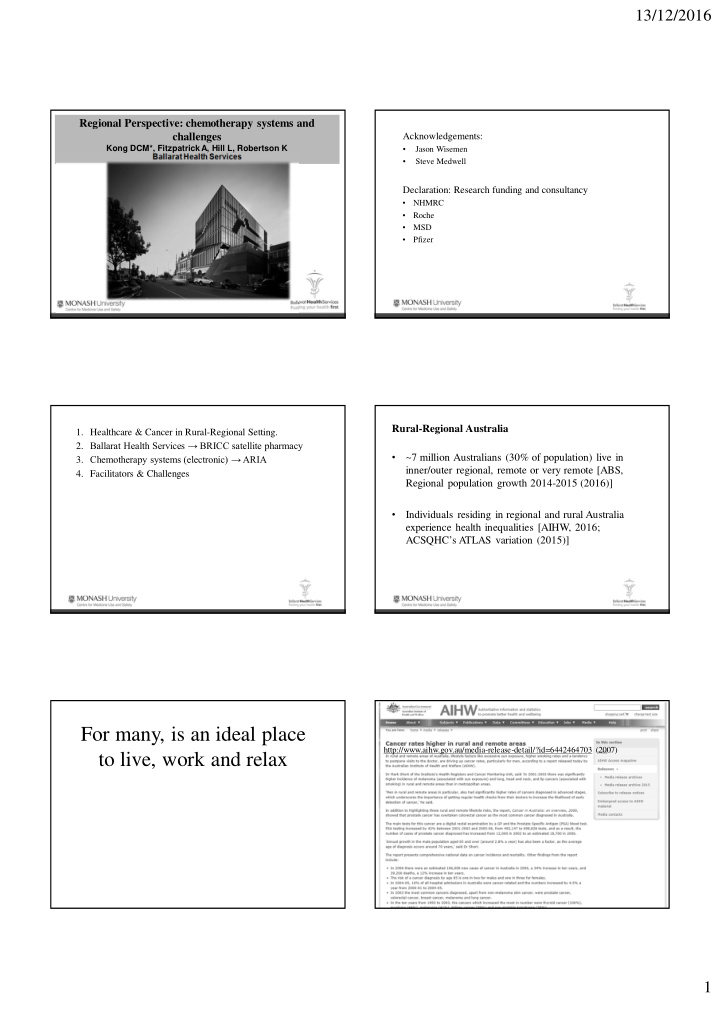



13/12/2016 Regional Perspective: chemotherapy systems and challenges Acknowledgements: Kong DCM*, Fitzpatrick A, Hill L, Robertson K • Jason Wisemen Ballarat Health Services • Steve Medwell Declaration: Research funding and consultancy • NHMRC • Roche • MSD • Pfizer Rural-Regional Australia 1. Healthcare & Cancer in Rural-Regional Setting. 2. Ballarat Health Services → BRICC satellite pharmacy • ~7 million Australians (30% of population) live in 3. Chemotherapy systems (electronic) → ARIA inner/outer regional, remote or very remote [ABS, 4. Facilitators & Challenges Regional population growth 2014-2015 (2016)] • Individuals residing in regional and rural Australia experience health inequalities [AIHW, 2016; ACSQHC’s A TLAS variation (2015)] For many, is an ideal place http://www.aihw.gov.au/media-release-detail/?id=6442464703 (2007) to live, work and relax 1
13/12/2016 Cancer in Rural-Regional MJA(2013); 199 (9): 605-609 • 108, 000 new cases (2007) • 39,000 deaths (2007) • ~33% live in regional & rural areas MJA(2014); 201(8): 445-446 Cancer in Rural-Regional Factors contributing to lower survival rates cancer patients in rural areas: 1. Less availability of diagnostic and treatment services 2. Later diagnosis 3. Lower socioeconomic status 4. Reduced rates of physical activity 5. Increased rates of high risk alcohol consumption 6. Higher proportion of Aboriginal and Torres Strait Islanders 7. Increased sun exposure Fact Sheet 8: Cancer in rural Australia (National Rural Health Alliance & Clinical MJA(2013); 199 (9): 605-609 Oncological Society of Australia, 2012). Rural-Regional Australia 1. Healthcare & Cancer in Rural-Regional Setting. Targeting Zero. Supporting the Victorian hospital system to eliminate 2. Ballarat Health Services → BRICC satellite pharmacy avoidable harm and strengthen quality of care (Duckett S., Victorian 3. Chemotherapy systems (electronic) → ARIA Government 2016): 1. Weaker legislative requirements for oversight of safety and quality 4. Facilitators & Challenges in small hospitals 2. Gaps in capacity are greatest for rural hospital Boards 3. Full- and part-time doctors are resistant to attempts to influence their practice 4. Small hospitals remain unlikely to have sufficient useful information on relative performance 2
13/12/2016 BHS BRICC Satellite Pharmacy BHS Ballarat Regional Integrated Cancer Centre (BRICC) • Workload summary Satellite Pharmacy • Staffing profile 3 pharmacists 1.5 technicians • Manufacturing mostly outsourced • Oncology Day Ward (~16 chairs) • Scripts from Outpatient Clinics and Clinical Trials BHS BRICC Satellite Pharmacy • Workload summary 1. Healthcare & Cancer in Rural-Regional Setting. 2. Ballarat Health Services → BRICC satellite pharmacy 3. Chemotherapy systems (electronic) → ARIA 4. Facilitators & Challenges Chemotherapy systems (electronic) • CHARM (http://www.charmhealth.com.au/) • ARIA (https://www.varian.com/oncology/products/software/information- systems/aria-ois-radiation-oncology) Ballarat Regional Integrated Cancer Centre Curr Oncol (2014); 21:224-233 3
13/12/2016 ARIA Interface • ARIA = Oncology Information System by V aria n Medical Systems • ARIA at BRICC: sharing information between Medical and Radiation Oncology Process Diagram Safety benefits (Aria): Build your chemo regimen → cross checking & sign -off • Enables protocols to be standardised, and authorised (entered by pharmacist, checked by oncologist) • Approx. 250 treatment protocols have been set up • Electronic recording of chemotherapy administration by nursing • Route management • Cr/ Cl (ml/min) – drug calculation for ordering • BSA calculation and dosing • Dose Capping and rounding • Cumulative Dosing Tracking ( e.g. Anthracycline life time dosing limits) • Allergy Recording and Checking • Adverse Reaction Recording • Drug Interaction Checking • Specific diagnosis specific treatment paths (Treatment regimens) 4
13/12/2016 Safety benefits (Aria): 1. Healthcare & Cancer in Rural-Regional Setting. • Visibility of medications between MO & RO (one way at this time) 2. Ballarat Health Services → BRICC satellite pharmacy • Centralisation of all medication data & pathology 3. Chemotherapy systems (electronic) → ARIA • No transcription errors (Legibility) 4. Facilitators & Challenges • Ordering errors eliminated • Pharmacy assistance in tracking and rectification of orders prior to dispensing and administration • Restriction of prescribing • Outreach support Facilitators: Challenges: • Growing demand – 36% increase in patients (FY 14-15 to 15-16) • Supporting Horsham, Hamilton, Stallwell ARIA-related: • Outages (unavailability of drug charts) • One ‘stop shop’ with safety elements • Limited bedside access / at point of care • Interaction with other systems (i.e. iPharm) • PBS Scripting not enabled • User Access and Rights • Maintenance of ARIA: E.g. updating/reviewing protocols (i.e. new / old) → ~280 protocols at BHS Training required for end users → VMOs • • No integration with iPharmacy Challenges: Challenges: Human factors: Supply → outsource vs in -house • • Training opportunities for staff • No integration with external manufacturing contractor(s) as yet • Qualified staff / expertise to accommodate increasing demand • Managing growing number & complexities of clinical trials • Communication & access to visiting VMOs Complacency → medical staff approving of orders without • appropriate checking first 5
13/12/2016 In conclusion: 1. Demand for cancer services in rural & regional setting continues to increase 2. Ensuring allocated staffing resources are aligned with increasing workload is a challenge in maintaining quality of service 3. Oncology information systems are available to support operations 4. Challenges remains but………………. 6
Recommend
More recommend